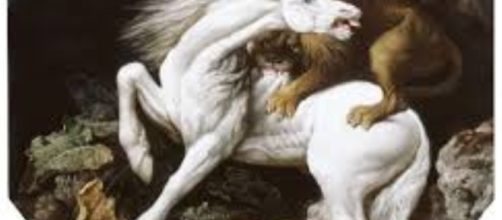This is a story about finding a diamond in the rough – in this case unearthing an Old Master painting in the dustbin of history. And just as crystals found in mines may seem only glassy rocks, so too can a valuable picture be overlooked as unremarkable. Archie Parker, a London dealer specializing in centuries-old paintings, had an inkling about a work dated 1879 that Huntington Library in San Marino, California was trying to unload at a Christie’s auction. He saw it as a gem by the famed 18th century English horse painter George Stubbs whose work has sold at Christie’s for as much as $36 million.
He bought the Huntington Library painting for $215,000, which would have been a lot of money if he were proved wrong.
Betting on a horse
As a horse painter, Stubbs may not be the household name that, say, Francisco Goya is (although one of his pictures is comparable to Goya’s “The Third of May.” More about that in a moment). Stubbs didn’t even rate membership in his own country’s National Academy because of what he chose to paint. He was dismissed by the art world as a sports Artist. And even when he painted a subject that other artists used, like The Reapers by Van Gogh or Sisley, you were bound to see a horse somewhere in it. In his version, the overseer is pictured on horseback. And despite the elegant 18th century English setting, Stubbs portrayed only the horse with nobility.
He did this a lot.
Shades of Francisco Goya
In effect, Stubbs’ subject-matter, then, was not simply horses, but the dignity of the animal. And here’s where the comparison with a Goya picture comes in. His “A Horse Frightened by a Lion” describes a lion about to assault a white-coated steed. And you imagine the animal’s pearly shade about to turn crimson from the wound it’s about to endure.
The pure white of the doomed horse in Stubbs’ art conjures up the white shirt of the doomed rebel before a Spanish firing squad in Goya’s “The Third of May," which you also anticipate will be bloodied when the shots go off.
To thine own self be true
Stubbs is said to have given all his attention to painting horses after seeing a lion in Morocco assault a horse.
So while his fellow artists in 18th century England like Gainsborough and Reynolds were painting portraits, landscapes and history paintings, Stubbs stuck with rendering horses. To hear Sir Walter Gilbey tell the story in the bio "The Life of George Stubbs," when the artist visited Rome as did his fellow painters, he didn’t do what they did and render drawings of antiquity. Instead he made the trip to “decide if Nature were superior to Art - whether Greek or Roman, ancient or contemporary.” As Gilbey put it, “He differed always in opinion from his companions, and when it was put to the vote, found himself alone on one side and his friends on the other.” You might say the same thing about Archie Parker, who recognized Stubbs’ painting when no one else did.

